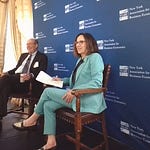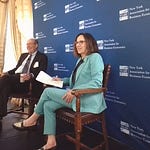As chief economist at the Conference Board, Dana Peterson keeps a very close eye on the U.S. labor market. And it’s clear to her that as inflation slows and the unemployment rises, the Fed’s assessment of the balance of risk in the U.S. economy will drive it toward three 25bps rate cuts by the end of this year.
Fed Chair Jay Powell does see the labor market now at the point where it is normalized and “he doesn’t want to see it go up at all,” Dana says.
”He’s putting the emphasis on the labor market, even over inflation now… and that’s because the Fed feels that they’ve kind of tackled the monster of inflation and that the risks that inflation is going to rise have more or less disappeared, but the downside risk is further weakening in the labor market,” she adds. “They don’t want to see risk further slowing in the labor market and that’s the downside risk they’re trying to weigh now.
So how big are he risks of a serious slowdown in the labor market?
”We think the labor market has normalized,” Dana says. Payrolls rising 400,000 to 500,000 per month as they did when the economy came from an emergency situation where people were reluctant to come back to work, the unemployment rate fell to 3.4% and the situation was inflationary.
She says the recent rise in unemployment is being driven by people re-entering entering the labor force anew. “For the most part I think the big concerns about the uptick in unemployment are probably a bit overdone.”
What if jobs growth does accelerate again, and inflation ticks up again? Could the Fed back off from rate cuts?
”I think it would really whipsaw markets if they don’t do something in September,” Dana says. There is a small probability that jobs could post strong gains and the unemployment rate tumbles, but I think they want to go (ahead with rate hikes) because credibility is important.”
The Fed wants to make sure it’s not causing gyrations in financial markets so it really about the size of the rate first rate cut, where Dana says “they won’t go 50 unless they see just a disaster in employment.”













Share this post